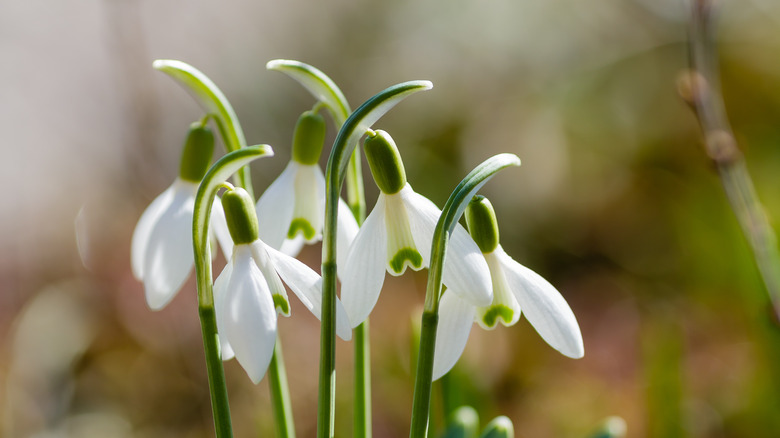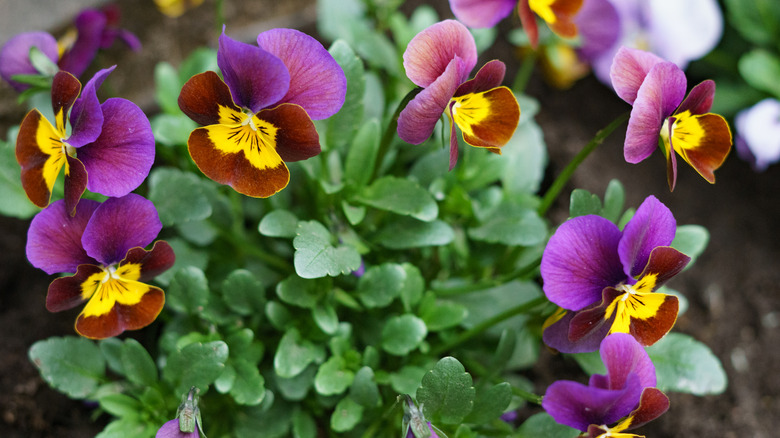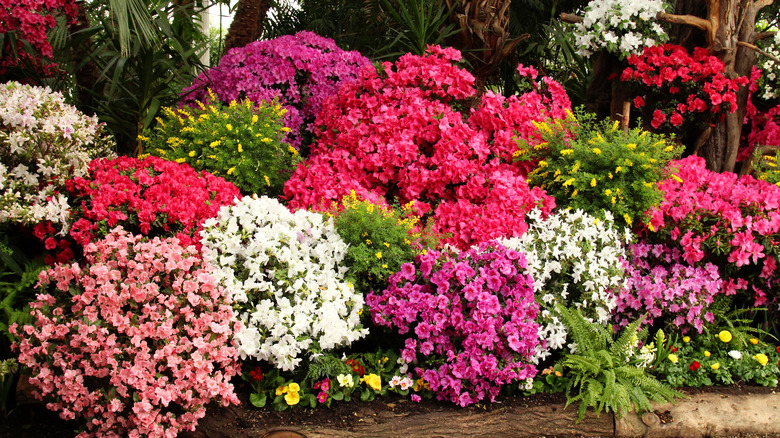15 Ways To Landscape Your Yard With Flowers
Landscaping services are in high demand across the United States. Homeowners are constantly looking for new ways to improve the visual appeal of their lawns and homes, and new plant life in the front yard is a perfect way to accomplish this task. As a result, landscaping is a huge industry in America and the world, with a total global market size of $105.1 billion and a total workforce of more than one million people in 2021 (via the National Association of Landscape Professionals).
A common means of revamping the front yard is through natural beautification. Adding elements to the lawn that occur more naturally in the community can make for a radiance in your curb appeal that's hard to match with any other approach. Angi reports that changes to the landscaping (specially designed to improve curb appeal) are some of the most cost-effective renovations that homeowners can engage in, with a return on investment nearing or exceeding 100% in many instances. Indeed, properties with great curb appeal average a 7% increase in resale value over those with an average or negative impact on the house in general.
Introducing flowers to your landscaping with some of these techniques and approaches can make for a revitalized lawn that is sure to turn heads and improve the level of relaxation that you enjoy while soaking in the sun and fresh air outside on the decking or porch space around your home.
1. Draw out your plans ahead of planting
SFGate reports that creating a scale drawing of the landscape can help streamline the following planting process. Planting new flower beds or trees isn't like building a wall or installing a deck. Once the organic matter has been placed, moving the installation can shock and kill the plant. Drawing out your plans before digging any holes can help you get the whole project right before you commit to any planting locations or organizational options.
2. Consider taking soil samples
In addition to drafting a plan to approach your planting endeavors, it's a good idea to take soil samples before starting to add flowers, trees, and other elements to the lawn (via SFGate). This additional step can be completed with the help of your local university extension office. It will also ensure that your garden can support the kinds of additions you are hoping to make. If your soil sample comes back with any issues, you can make adjustments to amend the soil and prepare it for successful cultivation.
3. Utilize a central feature
Flowers perform at their very best when paired with other elements of the garden that draw attention and demand that wow factor. Planting a central feature will give your lawn the greatest visual impact possible (via the University of Florida Extension). For instance, a tree or bush that produces colorful flowers each spring can add a unique element to the space that commands the attention of every onlooker. Likewise, viewing this feature from the front door or through the windows in the front portion of your home provides a striking feature that ties together the yard.
4. Organize vertically
Natural growth often segments itself into verticals. Arranging your landscaping with this same approach in mind can provide you with a lawn feature that provides a depth of organization and a variety of different types of plants that complement one another perfectly. For example, the University of Florida Extension recommends planting trees in the background with mid-ground and foreground planting extending forward from this point to include increasingly shorter plant varieties. These give way to ground layer flowers that tie the entire project together.
5. Spread horizontally
Horizontal planting is done best when utilized alongside the previous two approaches (via the University of Florida Extension). The horizontal organization provides a means to frame the central feature that draws the eye line into the whole image. Planting a commanding tree among bushes and flowerbed spaces that extend horizontally across the lawn provides a relief that looks and feels like a natural outgrowth and creates the striking visual appeal homeowners often look for in their landscaping.
6. Consider perspective
Planting flowers in a position that provides you with the color and foliage that grows out of the seeds or bulbs is essential. Growing anything is a positive change for the environment, but when adding new flowers to your garden beds, you'll want to think about your vantage point and plant with this perspective in mind (via Gardeningetc). In addition, placing the most beautiful flowers in a space that gives you visual access from the house and the street will impact your home's aesthetic and mood.
7. Bulk flowers together
The University of Florida Extension reports that bulking plants together is a great way to maximize the utility of your growing space. It's a good idea to learn about the growth patterns of any flowers you consider planting in your yard. You'll want to plant each new addition with enough space to grow into its mature height and width. When initially placing new shrubs, flowers, or trees, it might seem like there's quite a bit of space between plants, but this will fill in over time, and your planning will pay out.
8. Make use of patterns through color
Color patterns are a great way to accentuate individual aspects of the garden. You might want to highlight a few of your favorite flowers in the garden by clumping them together and then planting a contrasting option in the spaces around these favorites. The University of Florida Extension notes that when placing color variance and color highlights at a premium, it's important to consider all parts of the plant to understand the impact of the entire flower on the visual elements of the garden.
9. Match green and color together
Virtually all flowers and other plants bring a wealth of green stem and leafy material. Matching a background of green with pops of color throughout the landscaping design is a great way to make the area look luscious and full of wonderful growth (via Gardeningetc). Flowering components of the plants you add to the garden are only one aspect of the total image created in the process. Incorporating beautiful green space alongside and throughout the colorful flower additions is a great way to make the most of these and other plant varieties.
10. Pattern your yard with planting formations
Repetition can produce a stunning display of floral growth, according to Gardeningetc. Repeated patterns can make the lawn look more symmetrical by nature, leading to a greater sense of harmony and peace throughout the landscaping. This is a great way to make your yard into a more relaxing space, providing a much-needed disconnect from the fast pace of work and routine life. Repeating patterns make for an orderly yet still naturally wild environment that is relaxing and inspiring at the same time.
11. Make use of raised beds and other structural features
Raised garden beds can be used to effectively raise the height of your lowest layer up to match better with the overall scale of your landscaping project. Likewise, these additions make for an aesthetic choice that frames the garden more completely. Raised beds are especially helpful for making functional improvements as well, like in the case of a yard that needs increased soil drainage to protect ongoing growth (via SFGate).
12. Use long-flowering options for greater enjoyment
Long-flowering plants are a great addition to the lawn because they will bloom for longer, naturally. Mixing early and late season blooms together creates an evolution from start to finish during the warmer months (that typically see flowers in bloom). Some plants flower for much longer than others; including some of these into the mix can help keep the garden looking bright and colorful for a much extended period (via Gardeningetc.). It also prevents a stark drop-off in the color, which happens between blooming periods.
13. Consider textures in your planting diagram
Textures are another core feature of a well-designed garden. Plants will bloom with a variety of colors and in a range of heights and times. However, the flowering components of a plant aren't the only interesting feature of each member in your garden. The leafy stems, twigs, leaves, and flower petals all come together to form a visual texture palate that also plays a role in the garden's aesthetic (via the University of Florida Extension). As you add new features to the landscaping, keeping this in mind is crucial to preparing a pristine garden.
14. Amend soil as necessary
Soil amendments are often a necessary step in promoting continued growth and health in your garden (via Pennington). Plants draw nutrients out from the soil. Without a thriving ecosystem of different plant materials, animals (like worms), and other elements that naturally replenish soil nutrients, your flowers and trees will see a diminishing product as a result of lesser nutritional balance in the growing medium. Adding nutrients and fertilizer to the soil will help keep the environment balanced and give your plants what they need to thrive.
15. Don't be afraid to experiment
Experimentation is the key to success in any gardening adventure. The University of Florida Extension notes that horizontal and vertical layers underpin the visual package in a flower yard. Yet these basic elements can be laid out in virtually any combination that fits in with your desire for a specific color, height, and texture patterns. Therefore, planting something new each year can be a great way to experiment in small measure with the overall footprint of the landscaping while giving you a taste of something new and exciting with each new bloom.















